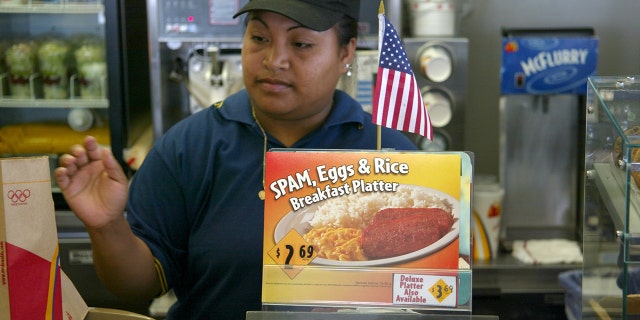SPAM, the canned processed meat product that has developed a cult following, was introduced by Hormel Foods on this day in history, July 5, 1937.
The mystery meat’s ingredients are not so mysterious after all, according to the official website for SPAM (a combo of the words “spiced ham”).
Consisting of “six simple ingredients” — pork with ham, salt, water, potato starch, sugar, and sodium nitrate — SPAM has “a relatively simple, conventional” production process, says its website.
ON THIS DAY IN HISTORY, JULY 4, 1802, THE U.S. MILITARY ACADEMY OPENS AT WEST POINT
The cans are then cooked and cooled for a three-hour period, are given labels and are then put into cases, the SPAM website details.
Beginning in 1941, SPAM was sent around the world to feed Allied troops during World War II, says the SPAM website.
ON THIS DAY IN HISTORY, JAN. 18, 1943, GOVERNMENT BANS SLICED BREAD AMID WORLD WAR II RATIONING
The popularity of SPAM has led to at least two annual festivals in the United States.
Austin, Minnesota, is also home to the SPAM Jam, a festival about all things SPAM-related.

Stacks of SPAM sit on grocery store shelves. The product has sold more than nine billion tins since it was introduced on July 5, 1937. (Getty Images)
While Hormel Foods is headquartered in Minnesota, another state has taken a particular liking to SPAM: Hawaii.
“More SPAM is consumed per person in Hawaii than in any other state in the United States,” says the website for the Waikiki SPAM JAM, the other SPAM-focused food festival.

A cashier at a McDonald’s location in Wahiawa, Hawaii, stands behind an advertisement for the then-new SPAM, Eggs and Rice Breakfast Platter in June 2002. Hawaii’s residents consume more SPAM than do residents of any other U.S. state. (Phil Mislinski / Getty Images)
SPAM is also a popular ingredient in various Asian cuisines, particularly Korean.
South Koreans consume more SPAM than the residents of any other country besides the United States, the Hormel Foods website notes.
Despite having only a sixth of the population of the United States, South Koreans consume half as much SPAM each year.

Budae jjigae, or “Army Stew,” was made from ingredients that were found on U.S. Army bases in South Korea after the Korean War, including SPAM. (iStock)
“Eventually these ingredients made their way into surrounding areas of the base and some creative Koreans made stew from them,” she said.
“They boiled spam, ham, sausages and baked beans with kimchi, garlic and hot pepper paste and flakes, creating a Korean-style stew with American ingredients.”
Even as South Korea’s economy rebounded, the stew — and SPAM as a whole — remained extremely popular.
Limited edition flavors SPAM Pumpkin Spice and SPAM Figgy Pudding were produced in 2019 and 2022, respectively, says the SPAM website.
In 2022, Hormel claimed that some 13 cans of SPAM were consumed every second, according to Encyclopedia Britannica.

